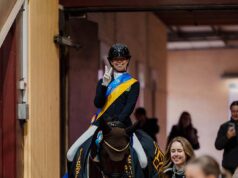By Margo van den Hoogen
This article is a non-assigned and voluntarily submitted opinion piece and does not necessarily reflect the views of World Breeding News. However, the exponential increase in embryos being sold at auction in 2022 prompted its publication, although we have also taken the liberty of adding editor comments at the end of the article.
This week I spoke to a horse professional who deals with breeders and owners on a daily basis, and he is worried about how things are going in the breeding business. In particular, he related the story of a disillusioned buyer of supposedly ‘top foals’ whom the poor man had bought at a ‘top auction’ and paid top prices. Under the best possibole conditions, the foals had been reared and four years later they were healthy and doing well under saddle.
His subsequent disappointment could not have been greater. They turned out to be nothing more than mediocre horses for amateur riders rather than the jumping cracks in which he’d hoped and believed. Over and out! The dream failed and his money had disappeared into a bottomless pit. He didn’t understand. How was it possible that at such a top auction they could brag and boast about the quality of the foals? He believed that he had been sold gems from the very best lines where it was almost certain – if the recommendations were to be believed – that these foals would, at the very least, become good jumpers, and could certainly belong to the top level.
One Grand Prix horse after another had been listed and he had trusted the expertise of the selection committee. Surely they know their stuff? This would never happen to him again, they should not think he was a nutcase that they could pull a leg twice.
Another buyer had bought two embryos for over €70,000, both turned out not to jump well. He, too, was profoundly disappointed and had no intention of ever making such an investment again based on the ‘hallelujah’ story that had won him over.
A sad reality in today’s horse world. After a prohibitively expensive purchase, these buyers were left out in the cold, and they are not the only ones. Their stories certainly don’t inspire confidence to invest in horses ever again.
Yet, one auction after another is headlining in favour of clients to acquire a ‘bang for your buck’, but how realistic are their claims? How does it work? Could buyers be presented with a more realistic picture on which to base their investments and not later consider that they have been led by the nose?
It seems that commerce around the sale of foals and embryos through auctions is pursuing a sales policy that is unfortunately based on poor information. One pretends to know very well what to expect from the foals on offer. Mirroring this, international jumping cracks from a dam line are listed to loud drumbeats, so buyers can lready see their foal’s name up in lights. But, yes... Too often the dream fails, sometimes due to a lack of accurate information, which is not surprising considering the fact that as few as one percent of all foals later jump 1m50/1m60 courses. Better for a buyer to keep both feet on the ground, I think.
Biased selection
A few years ago, I also wanted to take a foal to an auction and experienced how the sport information of a dam line is handled. The information I had myself submitted had not been included. When I asked why I was told that breeders often make up a lot of things, so they only used the results listed by Hippomundo! So, why ask breeders to provide any information at all, I wondered? But I looked to see what this website had to say about a dam line. Well, as it turned out, not so much. Behind the names of a few horses that had jumped internationally, nothing was listed or the level was too low. My request to change this led to a huge discussion.
Apparently, people were not willing to accept the performances of certain horses if they were from too long ago to be readily verified. Upgrading from 1m40 to 1m60 level was also a major problem, which had to be proven by official data. I had to move heaven and earth to get the granddam, who jumped internationally with John Whitaker, a stallion, who had competed at the highest level with Christan Ahlmann, a gelding, who competed at the European Championships with Christina Liebherr, and the dam of the foal who competed in the Sunshine Tour with Penelope Leprevost, listed at all and at the correct level. None of the foregoing are little-known riders who once jumped a course somewhere in Far-away-istan which could be truthfully verified... To read the complete article you need to be a subscriber
CLICK HERE TO SUBSCRIBE TO BREEDING NEWS
SUBSCRIBERS CAN READ THE COMPLETE ARTICLE BY LOGGING IN AND RETURNING TO THIS PAGE




